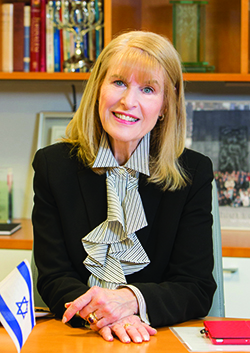Hadassah
President's Column
Dream, Build, Recycle
 Theodor Herzl titled his utopian novel about the rebirth of a Jewish state Altneuland (Old New Land) in recognition of the twin pillars of his vision—the history of the Jewish people in the Land of Israel and the renaissance that would flow from renewed sovereignty. While Israel still faces challenges, it cannot be denied that Herzl’s dream has been largely fulfilled.
Theodor Herzl titled his utopian novel about the rebirth of a Jewish state Altneuland (Old New Land) in recognition of the twin pillars of his vision—the history of the Jewish people in the Land of Israel and the renaissance that would flow from renewed sovereignty. While Israel still faces challenges, it cannot be denied that Herzl’s dream has been largely fulfilled.
Hadassah has its own ethic of valuing old and new. We built the foundations of Israel’s health care system and have constantly updated our methods of treatment and research, our equipment and our facilities. The Hadassah Medical Organization and our schools of medicine, nursing, dentistry, public health and occupational therapy are beacons to the world. Two graduates of the Hebrew University-Hadassah School of Medicine shared the 2004 Nobel Prize in chemistry.
In 2012, 99 years after two nurses set up the first Hadassah clinic in Jerusalem, we dedicated the Sarah Wetsman Davidson Hospital Tower, the state-of-the-art center of our Ein Kerem campus. But like a dynamic nation, the building of a great hospital is never complete. Innovations, discoveries, societal changes and population growth—not to mention the passage of time—all affect the way we use space.
Think of the activities that go on at our medical center. In the past few months, we’ve seen the following: A stem-cell therapy developed by Hadassah researchers to prevent and treat acute radiation syndrome was designated as eligible for guidance by the U.S. Food and Drug Administration for the next stage of clinical trials. Dr. Esti Galili-Weisstub, head of our child and adolescent psychiatry department and one of the world’s leading experts on adolescent PTSD, went to Mexico to consult with health officials and train physicians in the treatment of children impacted by the September earthquake.
We opened our new Neonatal Intensive Care Unit, combining advanced technology with private rooms and dedicated multidisciplinary health care professionals. Ours became the first medical center in Israel to offer low-fat, low-sugar meals to young patients. Dr. Dina Ben-Yehuda, head of HMO’s Department of Hematology, was named dean of the Hadassah-Hebrew University Faculty of Medicine, the first woman to hold the position.
Meanwhile, of course, our hospitals run 24/7, handling all the routine and emergency challenges of a world-class medical facility.
In medicine, constant movement is essential. Standing still means falling behind. Not only is HMO doing what it always does, it is doing more of it. From 2014 to 2016, as Israel’s population rose by 4 percent, HMO’s patient total grew by 9 percent; it delivered 13 percent more babies; performed 15 percent more surgeries and 32 percent more MRIs.
Increasing capacity is not only the key to serving our patients but also to HMO’s financial health—which brings me to how we cherish the old, not only in terms of history and values but also in real estate. When the Ein Kerem campus opened in 1961, its nerve center was the structure we affectionately call the Round Building. Fifty years later, it was that building’s aging interior and limited space that prompted us to build the Davidson tower. Now that the tower is functioning and the adjacent Round Building is vacant, we are launching a $90 million campaign to renovate the interior of the old facility, putting 21st-century infrastructure and equipment into its historic façade. The renovation will enable HMO to handle growth and support advances for decades to come.
The fundraising campaign is kicking off this month at our midwinter National Board meeting in Los Angeles and will join our milestone events of 2018, which include the centennial celebrations of our nursing school, the ophthalmology department and of HMO itself—not to mention the 70th anniversary of Israel’s independence.
We take pride in every new sign of Herzl’s dream fulfilled, but the Hadassah Medical Center is our gift to both Israel and the world. It’s no contradiction to say that our medical mission has a long history—and that we’re just getting started.










 Facebook
Facebook Instagram
Instagram Twitter
Twitter
Leave a Reply